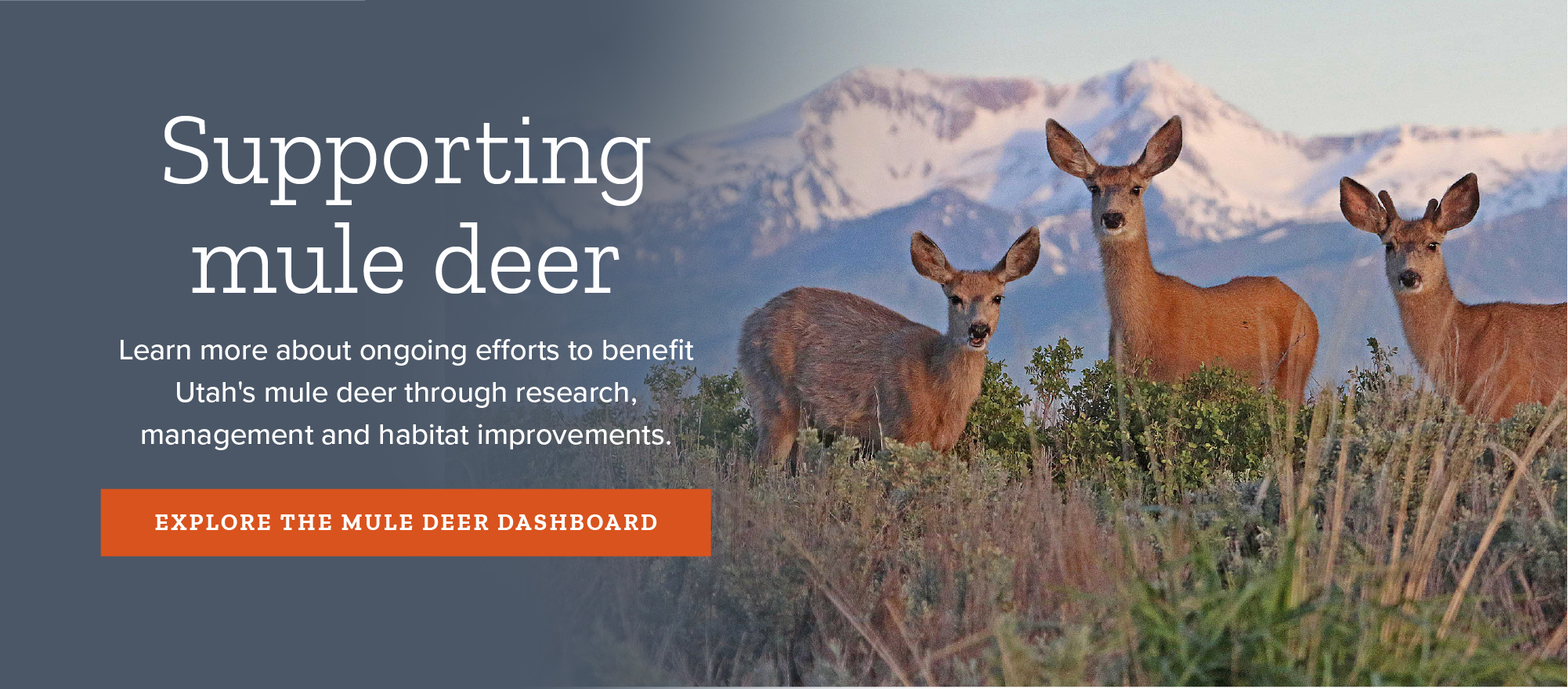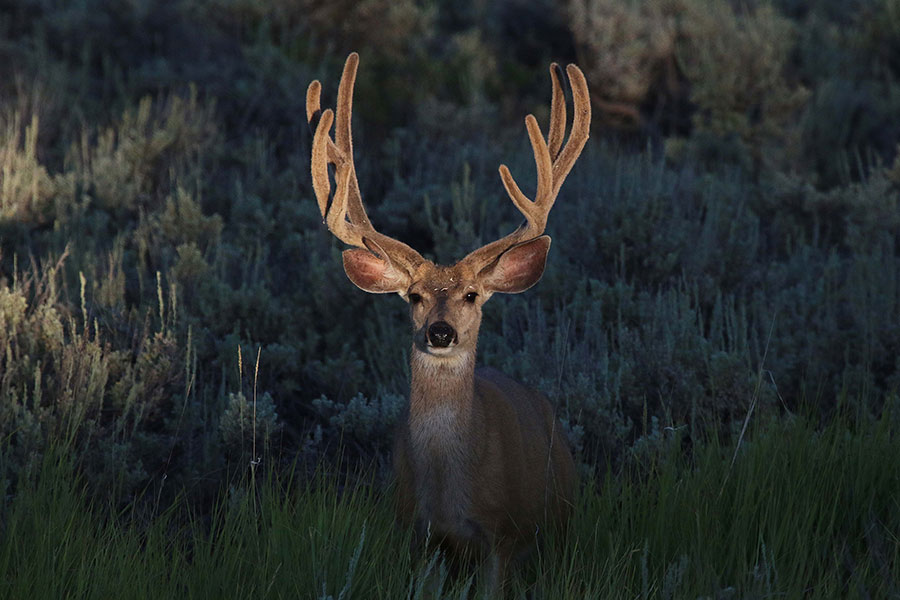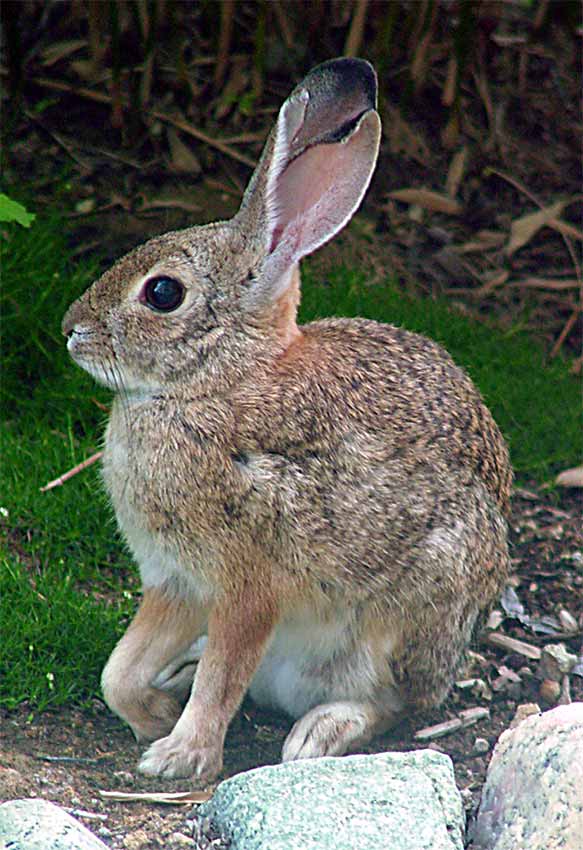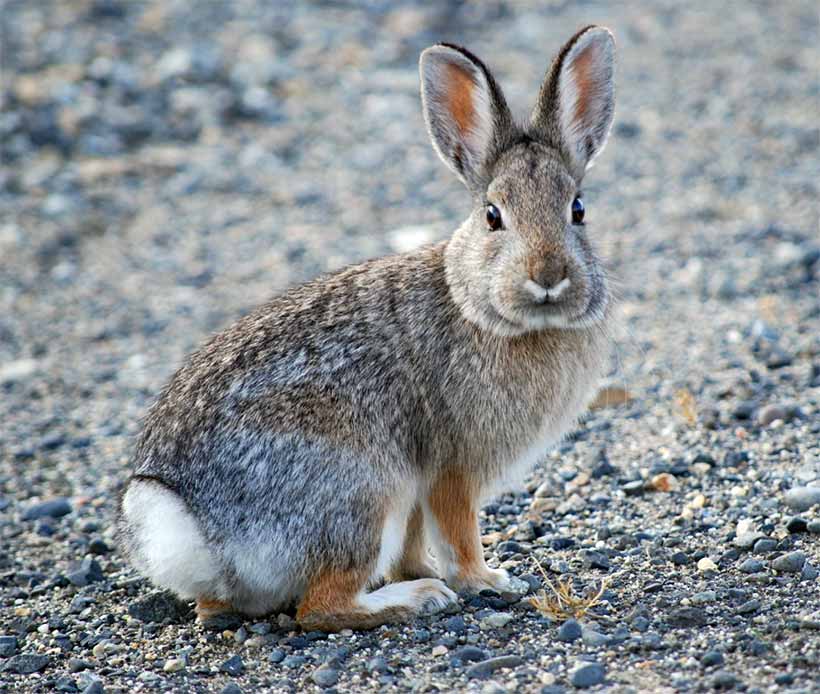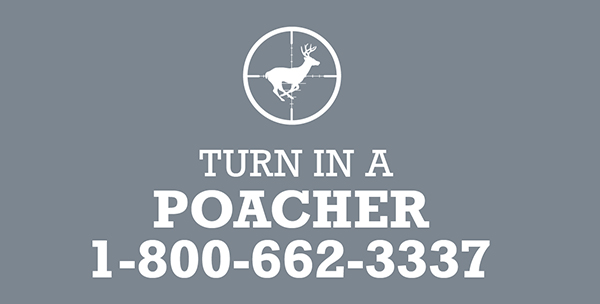Big game drawing odds & points reports
Information on past hunt applications for big game species
Are you looking for other species' reports, such as black bear, cougar or wild turkey?
Disclaimer: The following drawing odds and points reports should be used for informational purposes only. These reports do not guarantee that you will draw a permit in any given year. When you review the drawing odds, please keep in mind that the reports only reflect hunters' first-choice selections.
Due to the complexity of the odds for hunters' second through fifth choices — which can be affected by residency status, youth status, group applications, dedicated hunter selections and weapon types — those odds are not included in these reports.
2025
General-season permits
- General-season buck deer draw results
– PDF (1.6 MB)
- Lifetime general-season deer draw results
– PDF (1.4 MB)
- Youth general-season deer draw results
– PDF (1.6 MB)
- Youth draw-only elk draw results
– PDF (91.11 KB)
Limited-entry permits
- Big game limited-entry & once-in-a-lifetime draw results
– PDF (12.1 MB)
Antlerless permits
- Antlerless big game draw results
– PDF (3.4 MB)
- Youth antlerless big game draw results
– PDF (2.7 MB)
Points
- Big game and antlerless bonus and preference point purchase results
– PDF (208.32 KB)
Dedicated Hunter permits
- Dedicated Hunter deer draw results
– PDF (537.75 KB)
- Youth Dedicated Hunter deer draw results
– PDF (426.25 KB)
2024
General-season permits
- General-season buck deer draw results
– PDF (448.96 KB)
- Lifetime general-season deer draw results
– PDF (427.34 KB)
- Youth general-season deer draw results
– PDF (431.9 KB)
- Youth draw-only elk bonus point draw results
– PDF (74.31 KB)
Limited-entry permits
Antlerless permits
- Antlerless big game draw results
– PDF (756.7 KB)
- Youth antlerless big game draw results
– PDF (677.63 KB)
Points
- Big game and antlerless bonus and preference point purchase results
– PDF (90.8 KB)
- Youth draw-only elk bonus point draw results
– PDF (74.31 KB)
Dedicated Hunter permits
- Dedicated Hunter deer draw results
– PDF (196.38 KB)
- Youth Dedicated Hunter deer draw results
– PDF (177.39 KB)
Sportsman permits
- Sportsman draw odds report
– PDF (110.81 KB)
2023
General-season permits
- General-season deer draw results
– PDF (452.61 KB)
- Lifetime general-season deer draw results
– PDF (403.24 KB)
- Youth general-season deer draw results
– PDF (429.12 KB)
- Youth draw-only elk bonus point draw results
– PDF (74.91 KB)
Limited-entry permits
- Big game limited-entry & once-in-a-lifetime draw results
– PDF (2.9 MB)
Antlerless permits
- Antlerless big game draw results
– PDF (752.72 KB)
- Youth antlerless big game draw results
– PDF (673.01 KB)
Points
- Big game and antlerless bonus and preference point purchase results
– PDF (92.31 KB)
- Youth draw-only elk bonus point draw results
– PDF (74.91 KB)
Dedicated Hunter permits
- Dedicated Hunter deer draw results
– PDF (175.67 KB)
- Youth Dedicated Hunter deer draw results
– PDF (145.01 KB)
Sportsman permits
- Sportsman draw odds report
– PDF (99.85 KB)
2022
General-season permits
- General-season buck deer draw results
– PDF (1.4 MB)
- Lifetime general-season deer draw results
– PDF (1.3 MB)
- Youth draw-only elk bonus point draw results
– PDF (87.34 KB)
- Youth general-season deer draw results
– PDF (1.4 MB)
Limited-entry permits
- Big game limited-entry & once-in-a-lifetime draw results
– PDF (2.7 MB)
Antlerless permits
- Antlerless big game draw results
– PDF (2.8 MB)
- Youth antlerless big game draw results
– PDF (2.3 MB)
Points
- Youth draw-only elk bonus point draw results
– PDF (87.34 KB)
Dedicated Hunter permits
- Dedicated Hunter deer draw results
– PDF (520.01 KB)
- Youth Dedicated Hunter deer draw results
– PDF (361.05 KB)
Sportsman permits
- Sportsman draw odds report
– PDF (120.33 KB)
2021
General-season permits
- General-season buck deer draw results
– PDF (1.4 MB)
- Lifetime general-season deer draw results
– PDF (1.3 MB)
- Youth draw-only elk bonus point draw results
– PDF (86.87 KB)
- Youth general-season deer draw results
– PDF (1.3 MB)
Limited-entry permits
- Big game limited-entry & once-in-a-lifetime draw results
– PDF (10.1 MB)
Antlerless permits
- Antlerless big game draw results
– PDF (2.7 MB)
- Youth antlerless big game draw results
– PDF (2.5 MB)
Points
- Youth draw-only elk bonus point draw results
– PDF (86.87 KB)
Dedicated Hunter permits
- Dedicated Hunter deer draw results
– PDF (519.43 KB)
- Youth Dedicated Hunter deer draw results
– PDF (334.95 KB)
Sportsman permits
- Sportsman draw odds report
– PDF (153.05 KB)
2020
General-season permits
- General-season buck deer draw results
– PDF (1.3 MB)
- Lifetime general-season deer draw results
– PDF (1.3 MB)
- Youth draw-only elk bonus point draw results
– PDF (89.64 KB)
- Youth general-season deer draw results
– PDF (1.3 MB)
Limited-entry permits
- Big game limited-entry & once-in-a-lifetime draw results
– PDF (9.7 MB)
Antlerless permits
- Antlerless big game draw results
– PDF (2.8 MB)
- Youth antlerless big game draw results
– PDF (2.6 MB)
Points
- Youth draw-only elk bonus point draw results
– PDF (89.64 KB)
Dedicated Hunter permits
- Dedicated Hunter deer draw results
– PDF (481.92 KB)
- Youth Dedicated Hunter deer draw results
– PDF (387.49 KB)
Sportsman permits
- Sportsman draw odds report
– PDF (130.8 KB)
2019
- 2019–20 sportsman drawing odds report
- 2019 big game drawing odds report for limited-entry and once-in-a-lifetime
- 2019 general-season deer drawing odds report
- 2019 Dedicated Hunter drawing odds report
- 2019 lifetime general-season deer drawing odds report
- 2019 youth any bull elk drawing odds report
- 2019 youth Dedicated Hunter drawing odds report
- 2019 youth general-season deer drawing odds report
- 2019 antlerless drawing odds report
- 2019 youth antlerless drawing odds report
2018
- 2018–19 sportsman drawing odds report
- 2018 big game drawing odds report for limited-entry and once-in-a-lifetime
- 2018 Dedicated Hunter drawing odds report
- 2018 general-season deer drawing odds report
- 2018 lifetime general-season deer drawing odds report
- 2018 youth any bull elk drawing odds report
- 2018 youth general-season deer drawing odds report
- 2018 youth any bull elk drawing odds report
- 2018 antlerless drawing odds report
- 2018 youth antlerless drawing odds report
- 2018 sportsman drawing odds report
2017
- 2017 sportsman drawing odds report
- 2017 big game drawing odds report
- 2017 preference point summary by residency and species
- 2017 general-season deer preference point purchase, bonus points, drawing odds report
- 2017 dedicated hunter preference point purchase, bonus points, drawing odds report
- 2017 lifetime general-season deer permit drawing odds report
- 2017 youth general-season deer preference point purchase, bonus points, drawing odds report
- 2017 youth any bull elk drawing odds report
- 2017 antlerless preference point draw results
- 2017 antlerless bonus point draw results
- 2017 antlerless bonus point purchase results
- 2017 antlerless youth preference point draw results
- 2017 antlerless youth bonus point draw results
2016
- 2016 sportsman drawing odds report
- 2016 big game drawing odds report
- 2016 general-season deer preference point purchase, bonus points, drawing odds report
- 2016 preference point summary by residency and species
- 2016 lifetime general-season deer permit drawing odds report
- 2016 dedicated hunter preference point purchase, bonus points, drawing odds report
- 2016 youth any bull elk drawing odds report
- 2016 antlerless drawing odds report
- 2016 antlerless preference point draw results
- 2016 antlerless bonus point draw results
- 2016 antlerless bonus point purchase results
2015
- 2015 big game drawing odds report
- 2015 general-season deer preference point purchase, bonus points, drawing odds report
- 2015 preference point summary by residency and species
- 2015 lifetime general-season deer permit drawing odds report
- 2015 dedicated hunter preference point purchase, bonus points, drawing odds report
- 2015 youth any bull elk drawing odds report
- 2015 antlerless drawing odds report
- 2015 antlerless preference point draw results
- 2015 antlerless bonus point draw results
- 2015 antlerless bonus point purchase results
2014
- 2014 sportsman drawing odds report
- 2014 big game drawing odds report
- 2014 bison bonus point purchase, bonus points, drawing odds report
- 2014 bull moose bonus point purchase, bonus points, drawing odds report
- 2014 dedicated hunter preference point purchase, bonus points, drawing odds report
- 2014 desert bighorn bonus point purchase, bonus points, drawing odds report
- 2014 general-season deer preference point purchase, bonus points, drawing odds report
- 2014 lifetime general-season deer permit drawing odds report
- 2014 limited-entry deer bonus point purchase, bonus points, drawing odds report
- 2014 limited-entry elk bonus point purchase, bonus points, drawing odds report
- 2014 mountain goat bonus point purchase, bonus points, drawing odds report
- 2014 preference and bonus point summaries by residency and species
- 2014 pronghorn bonus point purchase, bonus points, drawing odds report
- 2014 Rocky Mountain bighorn bonus point purchase, bonus points, drawing odds report
- 2014 antlerless drawing odds report
- 2014 antlerless preference point draw results
- 2014 antlerless bonus point draw results
- 2014 antlerless bonus point purchase results
2013
- 2013 sportsman drawing odds report
- 2013 big game drawing odds report
- 2013 bison bonus point purchase, bonus points, drawing odds report
- 2013 bull moose bonus point purchase, bonus points, drawing odds report
- 2013 desert bighorn bonus point purchase, bonus points, drawing odds report
- 2013 elk bonus point purchase, bonus points, drawing odds report
- 2013 general season deer preference point purchase, bonus points, drawing odds report
- 2013 limited-entry deer bonus point purchase, bonus points, drawing odds report
- 2013 preference point summary by residency and species
- 2013 pronghorn bonus point purchase, bonus points, drawing odds report
- 2013 Rocky Mountain bighorn bonus point purchase, bonus points, drawing odds report
- 2013 mountain goat bonus point purchase, bonus points, drawing odds report
- 2013 antlerless drawing odds report
- 2013 antlerless preference point draw results
2012
- 2012 big game drawing odds report
- 2012 bison bonus point purchase, bonus points, drawing odds report
- 2012 bull moose bonus point purchase, bonus points, drawing odds report
- 2012 desert bighorn bonus point purchase, bonus points, drawing odds report
- 2012 elk bonus point purchase, bonus points, drawing odds report
- 2012 general season deer preference point purchase, bonus points, drawing odds report
- 2012 limited-entry deer bonus point purchase, bonus points, drawing odds report
- 2012 preference point summary by residency and species
- 2012 pronghorn bonus point purchase, bonus points, drawing odds report
- 2012 Rocky Mountain bighorn bonus point purchase, bonus points, drawing odds report
- 2012 Rocky Mountain goat bonus point purchase, bonus points, drawing odds report
- 2011–2012 preference point summary by residency and species
- 2012 antlerless drawing odds report
- 2012 antlerless preference point draw results
- 2011–12 sportsman drawing odds report
2011
- 2011 big game drawing odds report
- 2011 antlerless preference point draw results
- 2011 big game bonus point draw results by hunt
- 2011 big game bonus point purchase results
- 2011 big game bonus point draw results by species
- 2010–11 sportsman drawing odds report
